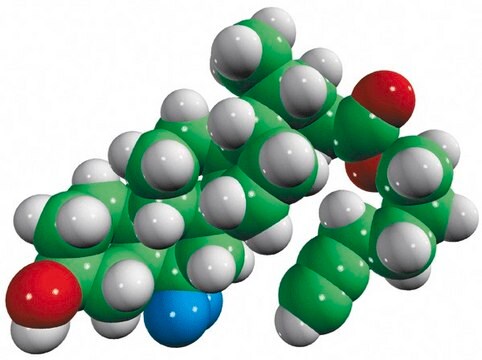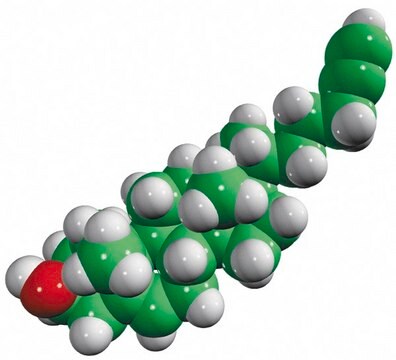804657
Photo-reactive Clickable trans-Sterol Probe
95%
同義詞:
(4R)-Hex-5-yn-1-yl 4-((3S,5S,10R,13R,17R)-3-hydroxy-10,13-dimethyl-1,2,3,4,5,7,8,9,10,11,12,13,14,15,16,17-hexadecahydrospiro[cyclopenta[α]phenanthrene-6,3′-diazirin]-17-yl)pentanoate
登入查看組織和合約定價
全部照片(2)
About This Item
經驗公式(希爾表示法):
C30H46N2O3
分子量::
482.70
分類程式碼代碼:
12352101
NACRES:
NA.22
推薦產品
品質等級
化驗
95%
形狀
powder
儲存溫度
2-8°C
SMILES 字串
C[C@H](CCC(=O)OCCCCC#C)[C@H]1CCC2C3CC4(N=N4)[C@H]5C[C@@H](O)CC[C@]5(C)C3CC[C@]12C
InChI
1S/C30H46N2O3/c1-5-6-7-8-17-35-27(34)12-9-20(2)23-10-11-24-22-19-30(31-32-30)26-18-21(33)13-15-29(26,4)25(22)14-16-28(23,24)3/h1,20-26,33H,6-19H2,2-4H3/t20-,21+,22?,23-,24?,25?,26+,28-,29-/m1/s1
InChI 密鑰
ZJMZIZZWLLQHJO-FNSUTPKXSA-N
尋找類似的產品? 前往 產品比較指南
應用
This is a photo-activatable sterol probe for the bioorthogonal tagging and enrichment of sterol-binding biomolecules. This sterol probe contains an intact steroid core structure bearing a diazirine UV-activatable cross-linking group as well as an alkyne group for click-chemistry mediated attachment of reporter and affinity tags. The probes are cell-permeable allowing for in situ labeling of biomolecules in live cells as well as in cell extracts in vitro.
其他說明
Handle the probes in amber vessels under dim ambient light whenever possible. Aqueous solutions of probes complexed to methyl-β-cyclodextrin (20:1 m-β-CD:probe molar ratio, 5-20 μM probe) permeate cultured cells in complete serum-containing medium within 30 minutes at 37°C, and are cross-linked using near-UV (365 nm) light for 3-10 minutes. Cells can then be harvested and lysed, fractionated, or otherwise processed. Click chemistry (Cu(I)-catalyzed 1, 3-dipolar cycloaddition of the alkyne with an azide reporter tag such as a fluorophore or biotin, products #760765 or #762024) can be performed in protein samples in PBS for gel-visualization of probe-labeling, MS-based proteomics analysis of probe-mediated affinity enrichments or western blot analysis.
儲存類別代碼
11 - Combustible Solids
水污染物質分類(WGK)
WGK 3
閃點(°F)
Not applicable
閃點(°C)
Not applicable
Jonathan J Hulce et al.
Nature methods, 10(3), 259-264 (2013-02-12)
Cholesterol is an essential structural component of cellular membranes and serves as a precursor for several classes of signaling molecules. Cholesterol exerts its effects and is, itself, regulated in large part by engagement in specific interactions with proteins. The full
我們的科學家團隊在所有研究領域都有豐富的經驗,包括生命科學、材料科學、化學合成、色譜、分析等.
聯絡技術服務








